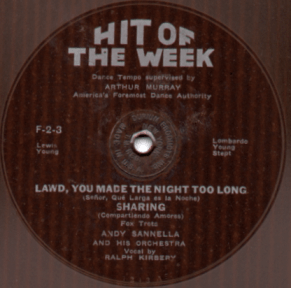Hit of the Week Records

Hit of the Week was a US record label introduced in 1930 and discontinued in 1932. Distinctively, Hit of the Week records were not made of the heavy, fragile shellac compound which was usual for phonograph records of that era, but of a patented flexible synthetic resin named Durium coated on a brown paper base. Like most popular-music 78 rpm records, they were approximately ten inches (25 cm) in diameter. Related products were introduced abroad, notably in the UK under the Durium label imprint. Some special-label custom records and small advertising records were produced by the same manufacturers.
History
Around 1930, several types of thin, flexible records made of various plastic formulations were introduced in Europe, such as the German Phonycord, French Pathé Cellodisc and British Filmophone and Goodson records. The only major US representative in this short-lived trend was the Hit of the Week record, which debuted in February 1930. As the name implied, a new issue featuring a current "hit" popular song was released every week. Unlike other records, they were sold at newsstands, like a weekly magazine. Previous issues could be obtained by mail order. Retailing for 15 cents each (later raised to 20 cents), Hit of the Week records were by far the lowest-priced records sold in the US at that time.
Their particular lightweight, flexible, "unbreakable" composition was unique. Apart from a tendency to low-frequency rumble due to a slight texturing of the surface (practically inaudible when the discs are played on a typical contemporary record player, but sometimes very obtrusive when played with later "Hi-fi" equipment), audio fidelity was equal to or better than ordinary shellac records. Unusually, Hit of the Week records had a recording on one side only, an early record industry practice which other manufacturers had long since abandoned. As a consequence of being uncoated on the other side, they have a strong tendency to curl and now often require the use of a clip or weight around the turntable spindle to keep them sufficiently flat during play. Some releases had the performer's portrait printed on the uncoated paper side, or were imprinted there with advertising matter. They were issued in flimsy rice paper sleeves, few of which have survived.
At first, the Hit of the Week series was very successful. By the summer of 1930, up to half a million copies of each week's issue were being produced to meet the demand. However, as the Great Depression worsened, sales of even the inexpensive Hit of the Week discs slumped. In March 1931 the company went into receivership and in May it was purchased by the Erwin, Wasey & Company advertising agency. A new format debuted in August, featuring two songs or dance tunes on each single-sided disc and a total playing time of about five minutes, but the economy continued to contract and the label remained unprofitable. The final Hit of the Week issue was released in June 1932.
Concurrently, and continuing for about a year after the demise of the Hit of the Week label itself, some limited use was made of smaller (often only four inches in diameter) records made of the same material, mostly for giveaway advertising novelties. Specimens of one of the most common advertising records, which invited the recipient to come see the new 1932 Chevrolet, are usually found with a mailing label and postage on the uncoated back side.
Among popular artists of the time who recorded for Hit of the Week records were Gene Austin, Duke Ellington and His Orchestra (as the Harlem Hot Chocolates), Eddie Cantor (on a special 25 cent "Durium De Luxe" issue), Morton Downey and Rudy Vallee.
See also
Discographies:
- "Hit of the week Discography" - Hans Koert (Heinkenszand - The Netherlands) (1994–2007)
- "Durium (GB) Discography - Hans Koert (Heinkenszand - The Netherlands) (1994-2007)
- "Durium Advertisement and Custom Records Discography - Hans Koert - The Netherlands) (1994–2007)